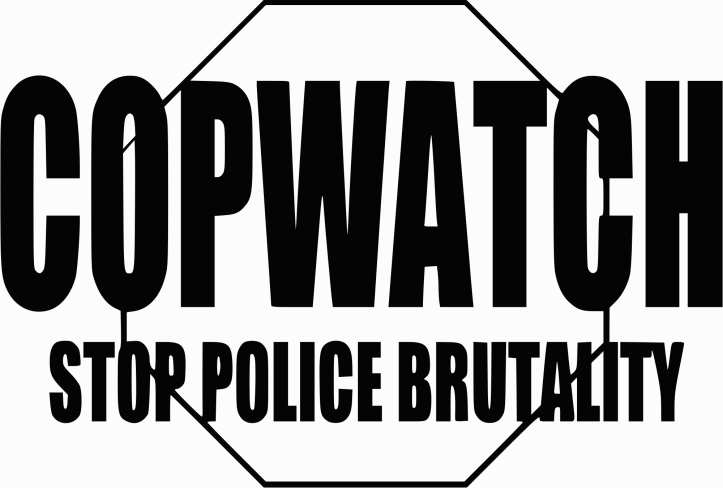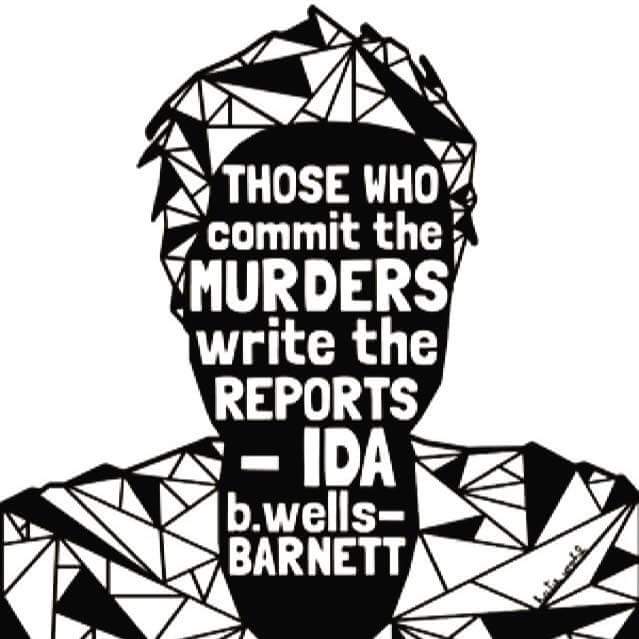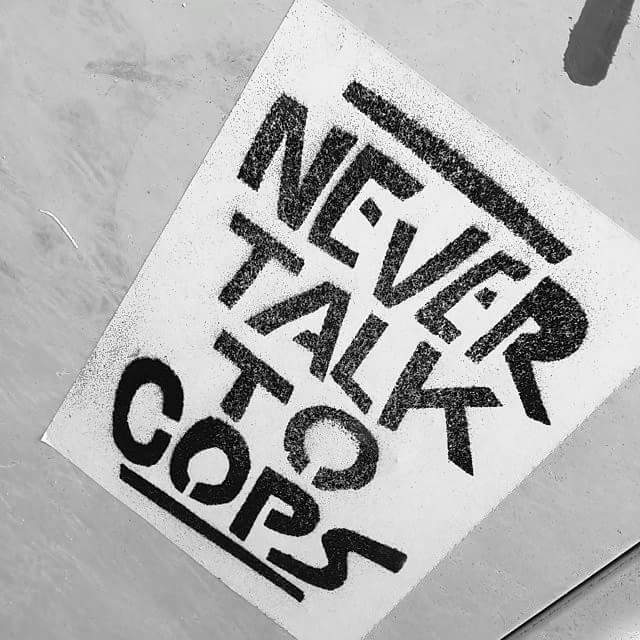In Los Angeles the police have been publicizing their new body camera program rolling out what will amount to 7,000 police body cams in the next coming years. Those of us who have been around cops with body cameras the last few years are not only not impressed, but critical of fanfare over the measure even though we haven’t seen any evidence it prevents police harassment real time. In fact, the opposite is true. Police harassment is increased with the use of body cameras. In 2015 alone “1138 people were killed by police in the US. That’s every 7hrs and 48 minutes someone was killed by cops. LAPD led the country. Here’s the link to these stats as published by Guardian newspaper: http://www.theguardian.com/us-news/ng-interactive/2015/jun/01/the-counted-map-us-police-killings
Instead of much demanded police accountability, the quick to band-aid body camera programs called “reform” actually work to expand the power of the police and further alienate and objectify the people they police.
1. Where did the idea for body cams come from?
You might be familiar with the term and the tactic of Copwatch. It is most likely that body cams have been adapted by the state in order to neutralize and counteract the tactics of copwatch, people deliberately observing, filming and documenting police harassment in their neighborhoods. This has been done for years with roots of intervening in police harassment going back to the black panther struggle, through purposeful counter patrols from LA to NY, and by decentralizing the tactic and encouraging everyone to FILM THE POLICE.
Filming the police has been helpful for numerous reasons, but still falls short from providing accountability or preventing police violence as most copwatchers will tell you. Some of the reasons it is helpful are 1) it can provide evidence in case of a trial to exonerate someone wrongfully charged or 2) can demonstrate evidence of police brutality or 3) immediately challenges the power dynamics of the police when you do it. But the reasoning remains, people film the police because they can’t trust what the police will do. The police are the watchers, so who watches the watchers? Not the body cams, that’s for sure.
2. When did it become branded “reform”?
The police began to wear body cams and eyeglass cams on a widespread scale after the suppression of the middle class leaning “occupy” movement in 2011, though recording has always been a method of infiltration. In some cases footage has helped center public outrage on an officer involved murder. Calls for body cams became popularized as reform after the Mike Brown uprising in Ferguson, MO. City representatives were quick to roll with the idea because in many places police were already using body cams to better surveill the public, gather intelligence and profile political agitators.
It’s important to remember that body cams were a repression tactic before they were branded “reform”.
3. More Funding and Tech for Cops, a For-Profit “Reform”
“The LAPD’s first wave of 800 cameras – costing $1.5 million – has been financed by 22 private donors, including director Steven Spielberg and the LA Dodgers organization, Tech Dirt reported. While traditional public funding would likely have been available, this one-time fundraiser has allowed the process to move much faster than it would have running through the usual city channels. ”
When the city, private investors and law enforcement want something done it always seems to happen quickly. Despite about a hundred suggestions to get to the root cause of over-policing, over-incarcerations, and profiling or harassment of black and brown people that can result in death or execution-by-cop, somehow community sourced solutions don’t get the support that for-profit reforms do.
Who is funding the police is important, it shows who is interested in helping the police maintain their position in society as enforcers despite the death toll against black and poor communities. The police are losing legitimacy as an institution that uses violence under the guise of “keeping order”. An “order” that has shown itself to be at the expense or incarceration of people from resource deprived communities, even to the point of arbitrarily enforced death penalties by the police.
I guess there just isn’t a market for preventing policing, or making communities healthy, resourced and safe(r) without incubating racism through violent intervention and prisons. Predictive policing? Yeah there are security firms for that. Private prisons? There’s a market for that too, with customers like Whole Foods and Victoria’s Secret.
Don’t believe me? Check out New York where NYPD wanted to require a $36,000 copy fee for access to body cam footage.
Or Taser, a company invested in creating a new market in oppression technology for police, including cameras activated by taser use.
Body cameras for officers to film the communities they police is a venture in capitalism. An investment in policing, to make sure policing can regain legitimacy, with more tech to suppress community revolt long term. What better surveillance technology than the one communities think will bring them police accountability?
4. Not Accountability
The police as an organization are unaccountable to the public for their behavior as an intentional group of well funded armed enforcers. If you’ve studied the organization of the police, they have a very firm hierarchy and control the region we live in through districting and injunctions more directly than any other governing agency.
Sure, they have a Police Commission but everyone knows the commission is there to provide an outlet and quell the outrage to keep people from disrupting capital in more direct ways. There are literally no checks to real time police violence, once police are in conflict with a person that person is immediately criminalized. There is no basic trial and prosecution for executions by police, this is up to the discretion of the District Attorney who often is more interested in maintaining their relationship with law enforcement to prosecute the people they police.
Simply put, body cams are a data gathering tool. Do they gather data on police? Or on the people who are being policed? Who controls them? Who reviews the footage? Is it the same organization that is in need of the accountability to begin with? Next.
5. What is the problem? Racism, Policing and Executions.
The body cam debate mis-frames the concern that people have with the police, racism and the government in general.
Instead of addressing the uprising in LA after officer Darren Wilson was not charged for the murder of Mike Brown late 2014 and thousands of people took streets days in a row, ultimately with over 400 arrests, to show solidarity and demonstrate that racism and deadly policing are a problem from LA to Ferguson, Garcetti quickly got on the loud and in-public police body cam bandwagon. He wasn’t the only one and it was a very clear evasive tactic.
The problem is absolutely not whether we have enough police brutality caught on film of deadly executions by police. The problem is the actual, practical effects of policing as it has been constructed rooted in legacies of colonialism, anti-blackness, racism and property protection at the expense of black, brown and non white lives. No matter how many reforms are made, and body cams are absolutely not a reform, if this is ignored, then policing stays in tact.
Instead of recognizing structural racism in policing and social structural white supremacy as deeply rooted concerns that resonate with many people in many different ways, representatives like to hone in on one thing they can quite literally sell to the public at large and deflect. And that’s what body cams did, they deflected from a deeper conversation on racism and the logic and effects of policing. The state utilized how drawn people are to camera footage of police assault and executions, to evade from the larger questions of prevention of police terrorism.
6. Without Input or Feedback from the Public it would Impact
If you are not likely to be policed or harassed I am not interested in your intimate perspective in favor of body cameras for cops. This social structure creates an entire field in “advocacy” work on behalf of impacted people, while neglecting to actually hear from or empower the voices of people that experience oppression directly.
When LAPD was announcing body cams as if they were “new” and not just re-marketed to put down uprising, they were pressured to open up two town halls on the issue. Despite these two town halls, neither was about whether this new technology should or shouldn’t be used on the public. The decision had already been made and the town halls were mostly to answer questions about how the technology worked as a public relations event to make the LAPD appear open to feedback when that wasn’t the case.
“I was there at their call for a “community forum” and regardless of outrage and pushback by well researched organizers and activists, the LAPD had the forum rigged. Police Chief Beck explained that they didn’t call a forum for consent to purchase and acquire these cameras with thousands of dollars of tax payer money, but that they had called this meeting to inform the public of how they would be used!!” said a local community agitator X.
This wasn’t approved by communities in L.A. and no local areas were surveyed for input in the policy.
7. Surveillance
Despite reports from grassroots community organizations, these body cam policies continue to result in contracts with private manufacturers with new products marketed for policing with everything from data collection to facial recognition tech.
The relationship between public sector organizations like the police and private manufacturers from Taser Inc. to SpaceX continues to be one of accumulation when it comes to weapons and surveillance. One funds the other and drives the market, which in turn reflects and changes the policies that are used on the ground adapting new tech marketed towards policing.
We can see now that these policy changes are not a result of people lobbying their state for changes in policing, they are a response to a growing market of mass surveillance, including domestic drone use. In order to successfully adapt and integrate the tech in a time of heightened criticism of police, the state seems to be marketing these new technologies as “reform” even though no such thing can be proven.
8. Not Reform, but Repression
Even if you want the police to be recording (as opposed to recorded) and trust that their organization can do that responsibly, there is a strong likelihood that footage gathered will be used to increase profiling and criminalization of people of color for even engaging in ‘legal’ behaviors.
The police will be able to choose to store footage they have and decide whether they want to criminalize someone after the fact. They will be able to use footage to justify more surveillance or warrants based on presumptions on someone’s character or how they act in the presence of law enforcement. The footage will likely provide first person shooter video of violent police encounters rather than capture police behavior on camera.
The footage will allow them to scrutinize the behavior of people targeted by police to justify use of force, when originally, use of force is precisely the problem. In cases of police execution this can result in more victim blaming by police organizations and the media who often choose to focus on a person’s last moments rather than the decisions of the police to escalate or use deadly force.
9. Why Give More Tools to Killer Cops?
This is not a world in which we need police to better get their story straight before lying on the witness stand. That is the current reality in which we live, and Hollywood movies glamorize and normalize these cover ups on the regular. So it shouldn’t come as a surprise that the police will be allowed to review the footage before writing their official reports.
Unfortunately, police obtained footage via body cam is more likely to be used in court against someone arrested by the police than it is to be used against the police in court. This is because police are very rarely charged or put on trial for their misdeeds, which is up to biased prosecutors, so any evidence or body cam footage is still just as unlikely to be used against them in a court of law.
The result? Body cam footage will just be another tool for prosecution in criminal cases while police who often evade any charges or civil suits will be much less likely to have it used against them.
10. No Standards for Body Cam Use
There are little to no policies for footage when it comes to police use of force cases. Will footage be automatically submitted to court? Why do police have access to review the footage before writing their report if it was a measure to ensure checks and balances? Why would we allow that if it can be used as yet another tool for the police to cover up their abuse of power?
Despite major legal activism institutions and civil rights organizations calling for police body cams, there are no measures to minimize bias in reports. In fact large institutions, like the ACLU have just paved the way for police agencies to better manipulate the public while increasing mass surveillance and doing nothing to address police terrorism.
In closing…
Some people just don’t want to recognize let alone validate that communities do not trust the police for good reason. And those same people tend to auto affirm the measures taken by state legislature and city leaders to validate and re-empower the police despite the cost. Not to mention glamorizing the police while they test out their new BMW and Tesla brand name vehicles, or trailblaze onto the crime scene with a new autonomous vehicle. If you care more about police public relations than the deadly cost of policing you might be exactly who i am talking about.
I don’t have any doubt there will be legislation after legislation to seemingly address the movement against police terrorism. What I fear is these new laws regarding the police are likely to say more about regulating our behavior around police than to address over policing, racist criminalization, mass incarceration or police executions of black life. Police reform is unlikely to create any consequences that might prevent police use of force real time on patrol instead focusing minimally on how police behave after someone has been murdered.
Discrediting and delegitimizing police narratives is necessary to the project of creating alternatives to the police and the abolition of modern day policing altogether. Together, communities are more qualified to determine how to keep their neighborhoods and blocks safe without the violent occupying force of police. People who know the state is violent and not helpful have always had to look outside of police for problem solving. Together we can decentralize deescalation practices and tactics, and if needed, create direct response teams for crisis situations. More still, we can push back on the narrative that we need to replicate policing ourselves instead of crafting other ways of self organization and intervention. Policing relies on violence, and without reimagining “public safety” we will continue to have deadly outcomes of police involvement in communities.
More resources:






FTP!
LikeLike
thank you for writing this article. it’s very necessary. i do have a question about the image which talked about community autonomy. from what book is that excerpt from? i would love to read it. thank you again!
LikeLike
Thank You! I have not been able to find it online! I read it printed in zine format and took a picture. When i get the chance and find the zine i will scan it and post it online!
LikeLike
[…] A New Market in Police Terrorism – 10 Reasons Why Body Cams Fail: https://exdystopia.wordpress.com/2016/01/15/a-new-market-in-police-terrorism-10-reasons-body-cams-fa… […]
LikeLike